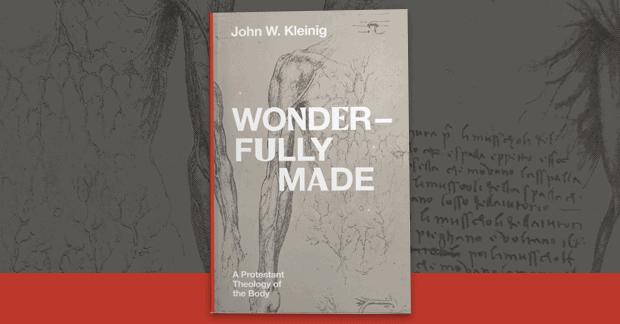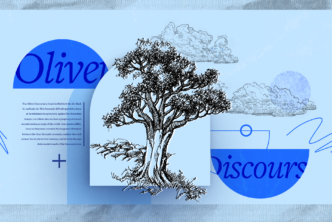In this excerpt from Wonderfully Made: A Protestant Theology of the Body, Dr. John W. Kleinig explores the creation account from Genesis 1–2 and five things we can learn about humankind from God’s spoken word in Genesis 1:26 and its interpretation in 1:27 and 5:1b–2.
***
Genesis 1:1–2:3 alludes, rather briefly and enigmatically, to the invisible mystery of the human body by mentioning its eternal orientation and its likeness to God, two themes that are merely introduced without any elaboration. That comes later in the Bible.
We get a hint about the human body’s eternal destination when God rests on the seventh day, the culmination of his creative acts. At first the seventh day seems out of place; it does not fit in with what precedes, for on this day God says nothing and creates nothing. He merely “rests” from his completed work of creation. After blessing the fish and the birds and man, he “blesses” this day and “sanctifies” it by resting on it. Yet despite its apparent misfit, it is the climax of the whole account, and it touches on three mysteries.
First, the culmination of God’s creative work for six days [and] his rest on the seventh sets the weekly rhythm and pattern for the human body: work and rest. For six days, man and woman were to work with God on earth; on the seventh day they were to rest with God in order to receive his blessing. Second, God sanctifies the seventh day so that by resting bodily with God on that day, which was later called the Sabbath, they could share in his holiness (Exod 20:8–11; 31:12–17). Third, unlike every other day, there is no mention of the beginning and end of the seventh day. Since it is God’s day, it is eternal. While it is set in the time for human life on earth, it transcends all time; it belongs to eternity. It shows that the human body had been created for eternal life by resting with God in heaven rather than just for temporal life on earth with care for its plants and animals.
Genesis 1 discloses another aspect of the mystery of the human body by saying that it was created in God’s image. That’s what makes humans theologically different from the animals, which, like them, also received physical bodies and the power to procreate. In simple terms, human beings are the only physical creatures made to resemble God. Thus, God announces what he proposes for human bodies with the very words by which he creates humankind: “Let us make man (Hebrew ’adam) in our image, after our likeness” (Gen 1:26). Then follows this poetic description of man’s creation:
So God created man (Hebrew ha’adam) in his own image,
in the image of God he created him;
male and female he created them. (Gen 1:27)1
These three step-like lines, with their repetition and variations, play on the four senses of ’adam in Hebrew: “man” as the term for any human person, humankind as a whole (which includes people of both sexes), a male person, and the primordial male figure Adam. Later on, after the account of the fall, we have this third summary in Genesis 5:1b–2:
When God created man,
he made him in the likeness of God.
Male and female he created them,
and he blessed them and named them Man (adam)
when they were created.
As in 1:27, we have the puzzling transition from a singular noun and a singular pronoun to the plural pronouns for male and female persons. This emphasizes that both men and women were created in God’s image.
The two key terms in these three passages are “image” and “likeness.” The more concrete term, “image,” is used elsewhere in the Old Testament for a painted picture of Babylonian soldiers (Ezek 23:14) and the statues that served as idols of Baal (2 Kgs 11:18). The more abstract term, “likeness,” derived as it is from the verb “resemble,” is used for the resemblance of Seth to his father Adam (Gen 5:3), the resemblance in a painting of the Babylonian soldiers to high-ranking officers (Ezek 23:15), and the assumed resemblance of an idol to its deity (Isa 40:18). Thus, they are virtual synonyms, even though they are used to make a fine distinction in Genesis 1:26 between “in our image” and “after our likeness.” Even though a human being is made to be like God, no human is divine by nature; no human is the image of God, as an idol was supposed to be the image of its deity by physically embodying it.
What God’s spoken word reveals about humankind
God’s spoken word for human creation in Genesis 1:26 and its interpretation in 1:27 and 5:1b–2 tell us five things about humankind.
1. All people were created by divine decree.
First, all people were created by a divine, creative utterance for bodily life on earth with each other and all other living creatures (Gen 1:26). That divine decree, that performative word, makes them what they are; it determines their status and purpose as human beings. Therefore, they derive their human nature and identity from God. They do not name themselves as they name all the other creatures (Gen 2:19); God himself names them so that he can address them personally and converse with them (Gen 5:2).
2. They were created ‘in his image.’
Second, unlike the idols of pagan gods in the ancient world and the kings of Egypt, they were not made as images of God but were only created “in his image.” In their humanity, they were to resemble the living God by reflecting him in what they were and what they did. They were to be holy as God himself was holy (Lev 11:45; 19:2; 20:26; 1 Pet 1:16). But we are not told who or what that image is. It is only in the New Testament that we discover that God’s Son, Jesus, is the image of God the Father, the one in whose image human beings were created (2 Cor 4:4; 1 Cor 15:49; Col 1:15; cf. Rom 8:29; Col 3:9–11; Heb 1:3).
So, to be in God’s image is to be like Jesus by union with him and participation in his communion with his heavenly Father. In his human body, Jesus shows us God the Father, so that when we see his Son, Jesus, we see God the Father (John 12:45; 14:9); by his human body we are remade in God’s image (Rom 8:29; 1 Cor 15:49). So even though God is spirit, a spiritual being without a body (John 4:24), he has designed our human bodies to manifest himself visibly and personally, just as idols were supposed to display pagan deities, and to foreshadow his incarnate Son and our bodily union with him.
3. They were created male and female.
Third, human beings were created in God’s image as male and female. In Hebrew, the terms “male” and “female” describe both their biological sex (Lev 12:2, 5, 7; 15:33), which they share with all the animals (Gen 6:19; 7:3, 9, 16), and their corresponding gender, their sexual identity (Lev 27:3, 4, 5, 7; Num 5:3). Both are given by God in their creation. So, both their sexual status and their gender are aspects of their creation in God’s image. Men and women were designed to reflect God’s character, his qualities, and his activity, each separately in their devotion to Jesus and together in their conjugal sexual union with each other.
Yet this account of their creation does not show us how they were to do this. It could be that they were to cooperate with him as the Creator in sexual procreation. However, that is not necessarily the result of their creation in God’s image, because the birds and fish and animals also procreate by their engagement in sexual intercourse. The answer to that is given much later, by Paul in Ephesians 5:22–33. They were created as male and female in God’s image to reflect Christ’s self-giving, self-sacrificing love for the church as his bride. His one-flesh union with the church is correlated, imperfectly and yet really, with the one-flesh union of husband and wife in marriage.
4. The whole of their body was made in God’s image to represent him.
Fourth, God did not just create some part of them with some of their faculties, such as their mind with its rational self-consciousness or their soul with its capacity for personal relationships; he made the whole of them in his image in order to represent him. The mention of their sexuality shows that this includes their bodies. Likewise, in Genesis 9:6, the reason for capital punishment for murder is that the victim is made in God’s image. The violation of a living, human body is an attack on God. The whole human being as a soul, a living person, with a human body and a human mind, was designed by the living God to reveal himself—however partially and imperfectly—in the person’s life on earth. The body of each person was made for theophany, for God’s human manifestation on earth, the visible disclosure of his glory in human terms. That is what human bodies were designed to do and what they have failed to do ever since the rebellion of our primordial parents (Rom 3:23). And that is what Jesus regained for all humanity to compensate for that failure (John 1:14, 16–18).
5. They were created for a task.
Fifth, even though the passages that speak about the creation of humankind in God’s image do not explain how they were meant to resemble him, they do describe what they were meant to do as creatures made in his likeness. As God’s vice-regents, they were to “have dominion” over all the fish and the birds and the land animals (Gen 1:26, 28). Just as God maintained the whole cosmic order and supervised its proper operation, all human beings, rather than just a few powerful kings, were to maintain proper order in the animal kingdom on earth, so that all animals, each in their own niche and in their own way, would thrive on earth together with all humankind. As managers of God’s earthly estate, they were to “subdue” the earth (Gen 1:28). They subdued it by farming it properly and protecting it from exploitation and abuse so that its vegetation would provide food to maintain and sustain human and animal life on earth (Gen 1:29–30).
Humankind was to be like God by serving as good stewards of the earth and its animals.
***
Read more about the creation account in Genesis 1–2 and the mystery of the body in Wonderfully Made: A Protestant Theology of the Body by John W. Kleinig, available now from Lexham Press. This article’s title and subheads are additions of an editor.
Dr. John W. Kleinig is Emeritus Professor of Exegetical Theology at Australian Lutheran College (formerly Luther Seminary), Adelaide, Australia. He studied at Adelaide University (BA with Honors), Luther Seminary (MDiv), and the University of Cambridge, England (MPhil and PhD).
Related articles
- Christology: Don’t Skip This Important Word
- 3 Insights about Genesis You’ve Probably Never Heard
- Explore Different Views of Genesis 1–2







